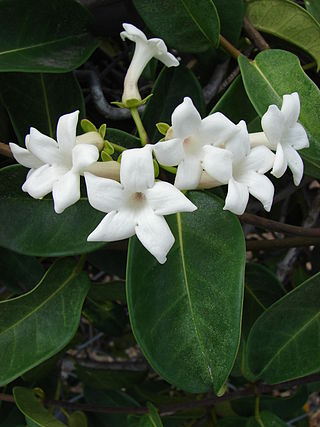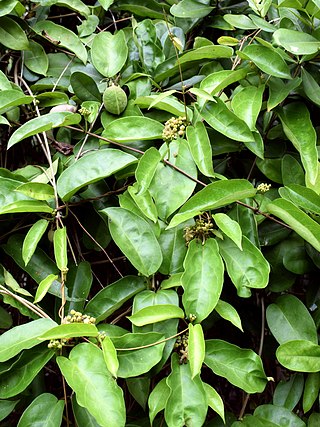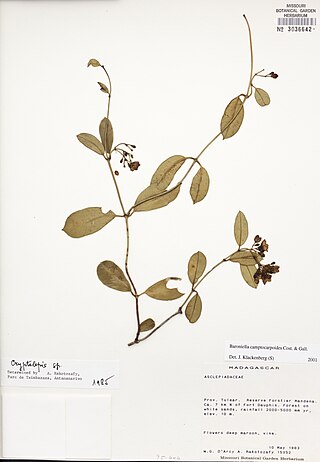
The Asclepiadoideae are a subfamily of plants in the family Apocynaceae. Formerly, they were treated as a separate family under the name Asclepiadaceae, e.g. by APG II, and known as the milkweed family.
Dischidia is a genus of plants in the “dog-bane” family Apocynaceae, collectively known as the “milkweeds”. They are epiphytes, native to tropical areas of China, India as well as Bhutan’s southern borders, wherever minimal frost occurs. Additionally, they are known from most areas of Indo-China, including forested areas of Myanmar, Thailand, Vietnam, Cambodia, Laos, and some parts of Malaysia and Singapore.

Marsdenia is a genus of plants in the family Apocynaceae first described as a genus in 1810. It is named in honor of the plant collector and Secretary of the Admiralty, William Marsden. The plants are native to tropical regions in Asia, Africa, Australia, and the Americas.
Julien Noël Costantin was a French botanist and mycologist who was a native of Paris.
Rhizomucor is a genus of fungi in the family Lichtheimiaceae. The widespread genus contains six species. Rhizomucor parasiticus, the species originally selected as the type, is now considered synonymous with Rhizomucor pusillus.

Sarcolobus is a plant genus in the family Apocynaceae, first established as a genus in 1809. It is native from Bangladesh through Southeast Asia, to New Guinea, Australia, and certain islands of the Western Pacific.
Macrocalyx is a taxonomic plant genus synonym that may refer to:
Lygisma is a plant genus in the family Apocynaceae, first described as a genus in 1883. It is native to southern China, Indochina, Malaysia, and the Himalayas.
- Lygisma angustifolia(Wight) Hook.f. - Himalayas
- Lygisma flavum(Ridl.) Kerr - Peninsular Malaysia
- Lygisma inflexum(Costantin) Kerr - Vietnam, Guangdong, Guangxi, Hainan
- Lygisma nervosumKerr - Thailand

Heterostemma is a genus of plants in the family Apocynaceae, first described in 1834. It is native to India, China, Taiwan, Southeast Asia, Australia, and certain islands in the Pacific.
Pentatropis is a genus of plants in the family Apocynaceae, first described as a genus in 1834. It is native to Africa and southern Asia.
Pentopetia is a plant genus in the family Apocynaceae, first described as a genus in 1844.
Ischnolepis is a species of plants in the family Apocynaceae first described as a genus in 1909.

Blastomyces is a genus of fungi in the order Onygenales. Species are known human pathogens and show thermal dimorphism, converting from hyphal states under saprobic conditions to yeast-like states under pathogenic conditions. They are the causative agents of blastomycosis, a systemic mycosis in immunocompromised patients.
Harzia acremonioides is a species of seed-borne fungus that occurs in the soil. It has been categorized in the Ceratostomataceae family and under the genus Harzia. The genus Harzia contained up to three accepted species: H. acremonioides, H. verrucose, and H. velatea in 1974. Within the genus Harzia, H. acremonioides is one of the most common species that can be found in all climate regions around the world.
Harzia is a genus of seed-borne fungus that occurs in the soil. It has been categorized in the Ceratostomataceae family. The genus Harzia originally contained three accepted species: Harzia acremonioides, Harzia verrucose, and Harzia velatea. Within the genus Harzia, Harzia acremonioides is one of the most common species that can be found in all climate regions around the world.
Finlaysonia is a genus of flowering plants in the dogbane family Apocynaceae, found from Sri Lanka, India, through Southeast Asia, New Guinea, northern Australia, the Philippines, and Palau. They tend to be vines or climbers and prefer to live on limestone, alongside rivers, or in mangrove swamps.
Telectadium is a genus of flowering plants belonging to the family Apocynaceae.
Baroniella is a genus of flowering plants belonging to the family Apocynaceae.

Baroniella camptocarpoides is a species of plant in the Apocynaceae family. It is endemic to Madagascar. Julien Noël Costantin and Ernest-Isidore Gallaud, the botanists who first formally described the species, named it after its resemblance to, but distinctiveness from, plants in the genus Camptocarpus.





